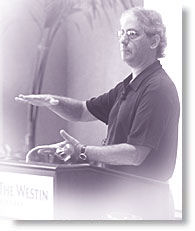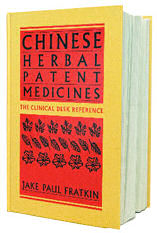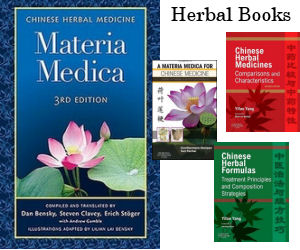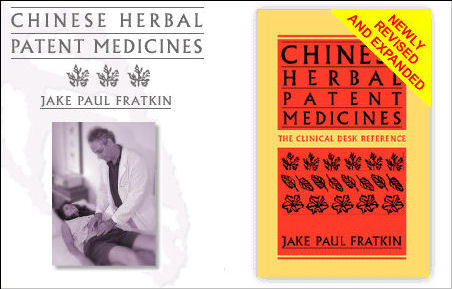Acupuncture & TCM Articles

Articles by Jake Paul Fratkin, OMD, LAc
Jake Fratkin, OMD, LAc, has been in the practice of Oriental medicine since 1978. Following undergraduate and graduate training at the University of Wisconsin in Chinese language and philosophy and pre-medicine, he pursued a seven-year apprenticeship in Japanese and Korean style acupuncture with Dr. Ineon Moon and a two-year apprenticeship in Chinese herbal medicine with Drs. Zhengan Guo and Pak-Leung Lau in Chicago. He also spent a year in Beijing hospitals interning in advanced herbal medicine, specializing in gastrointestinal and respiratory disorders, and pediatrics.  Dr. Fratkin is the author of several books, including Chinese Herbal Patent Medicines: The Clinical Desk Reference, and is the editor-organizer of Wu and Fischer's Practical Therapeutics of Traditional Chinese Medicine. In 1999, he was named the "Acupuncturist of the Year" by the American Association of Oriental Medicine.
Dr. Fratkin is the author of several books, including Chinese Herbal Patent Medicines: The Clinical Desk Reference, and is the editor-organizer of Wu and Fischer's Practical Therapeutics of Traditional Chinese Medicine. In 1999, he was named the "Acupuncturist of the Year" by the American Association of Oriental Medicine.
Chinese Herbal Patent Medicines: The Clinical Desk Reference
Hardback book, 1198 pages. This volume covers 1360 products, including 550 GMP level products and all of California FDB analysis on 505 products. Includes information on endagered animals, heavy metals, and pharmaceuticals. The text is organized into 12 groups, with a total of 109 chapters and includes material by Andrew Ellis, Subhuti Dharmananda, and Richard Ko. Over 80 pages of full-color photos (with English and Chinese cross-reference). Fully indexed.
Treating Traumatic Injury and Pain with Plum Flower Products
Chinese herbal formulas for traumatic injury have their origins in a subspecialty of Chinese medicine called die da yao, literally “trauma medicine’, and sometimes translated as “hit medicine’. This subspecialty developed in the martial arts schools and the military, both as medicines for injuries due to training, or injuries sustained in actual combat. They have an impressive clinical history dating back at least 2500 years. These formulas use herbs that invigorate blood and break stasis, move qi and warm the channels. Unlike Western therapies which ices and immobilizes sites of injuries, the Chinese approach of moving qi and invigorating blood allows the qi and blood to flow in an unimpeded way, allowing an injury to heal quickly while overall pain is reduced.

We can divide these products into two types. The first reduces swelling and promotes healing in traumatic sprain, bruising or fracture. The second group is used to stop bleeding, both externally or internally. Together, they offer a valuable repertoire for management of acute trauma, or pain following trauma.
Internal medicines for acute trauma can reduce swelling and promote healing in fractures and sprains. In China, bone setting experts will reset a fracture by hand every three days or so, using internal medicines while applying external liniments or herbal wraps. This approach allows healing in half the time, according to hospital physicians I have talked with. For western patients, use of internal medicines for traumatic injury allows healing when the site of the injury is isolated within a cast or splint.
There are also products that are specific for treating pain. They usually contain one or two ingredients, using herbs that have strong analgesic effect. These products can be taken alone or as reinforcement for other products. They are useful for pain due go trauma as well as headache, toothache, joint pain, epigastric pain, etc.
Herbs for trauma and pain invigorate blood and break stasis. They tend to be bitter, and excessive consumption can lead to nausea. Because these formulas use strong blood invigorating herbs, they can cause excessive menstrual bleeding if taken during the menstrual period. For similar reasons, they are prohibited during pregnancy. Many of the fracture and sprain formulas are contraindicated for bleeding injuries, as well as postpartum, miscarriage, and other diseases where bleeding is a risk. They are also prohibited for patients on Coumadin and other pharmaceutical blood thinners, because they can potentize the actions of the pharmaceutical drug.
Plum Flower offers five products that address traumatic injury or pain from traumatic injury.
THE GREAT MENDER TEAPILLS, JIN GU DIE SHANG WAN (MW#3619) is an elaboration of Xie Yuanqing´s formula Qi Li San, formulated in 1842. Although using the same Chinese name as the patent medicine CHIN KOO TIEH SHANG WAN, it is a very different formula. The Plum Flower version is most applicable for fracture with swelling. It is a complex formula (22 herbs), with 26% being Dipsacus Xu Duan, an herb most useful for healing broken bone. Twelve supportive herbs reduce swelling by invigorating blood, and include Boswellia Ru Xiang, Commiphora Myrrha Mo Yao, Paeonia Chi Shao, Carthamus Hong Hua and Sparganium San Leng. The formula is very useful for a fracture confined to a cast. It will reduce swelling and promote healing. It can also be used for trauma without fracture, in cases marked by swelling and bruising. It is less effective in micro-tears and soft tissue injury without swelling. The pills can also be powdered in a coffee grinder and mixed in rice wine or alcohol to make a topical application for traumatic swelling.
RED VESSEL TEAPILLS, HUO LUO XIAO LING WAN (MW#3361) is a modern formula from Zhang Xichun, formulated early in the 20th century. It is a simple four herb combination for acute trauma with swelling, using Angelica Dang Gui, Salvia Dan Shen, Boswellia Ru Xiang and Commiphora Myrrha Mo Yao. Besides traumatic injury, the formula is also applicable for ectopic pregnancy, cerebral thrombosis, hepatomegaly, splenomegaly and angina. It is also used to reinforce formulas for bi syndromes (arthritis, rheumatism, sciatica) due to blood stagnation, and can be used for and pelvic inflammatory disease (PID).
TIAN QI TEAPILLS (MW#3706) stops bleeding while invigorating blood. Notoginseng Tian Qi, also known as Pseudoginseng and san qi, is an excellent medicine for stopping bleeding, reducing swelling and bruising and acting as an anti-inflammatory. It is valuable for trauma and in chronic internal bleeding disorders. It is the chief ingredient in Yunnan Bai Yao, and in fact, as a single herb, may be a stronger topical hemostatic. Modern research has also indicated its usefulness in lowering blood pressure and reducing high blood cholesterol. This is raw Notoginseng Tian Qi. In its steamed or prepared form, it is used as a blood tonic.
GREAT CORYDALIS TEAPILLS, YAN KU SUO ZKI TONG (MW#3700) combines Corydalis Yan Hu Suo (66% of the formula) with Angelica Bai Zhi (33%). Corydalis Yan Hu Suo is considered the principal Chinese herb for relieving pain, especially the dull lingering type. All pain in Chinese medicine is considered the result of stagnation of qi and blood, and Corydalis Yan Hu Suo is a strong blood-moving herb. In this product, it is combined with Angelica Bai Zhi, which together helps to invigorate qi and blood. The formula acts like an herbal aspirin, useful in a variety of pain presentations including trauma, epigastric pain, stomach ulcer, headache, sinus pain, dysmenorrhea, postpartum pain and tooth pain. It is also used following stroke.
QI YE LIAN (MW#3931). Schefflera Qi Ye Lian is not well documented in the historical literature, but it is now generating clinical interest, investigation and use in China. It is considered an excellent and safe analgesic herb without the side effects of addiction, mental impairment, liver toxicity, or diminishing effect. One can use for acute and chronic pain due to injury, or rheumatic pains in the joints and muscles. Also useful in trigeminal neuralgia, headache, toothache, sciatic pain and lower back pain.
Traumatic swelling can also benefit from topical application of commonly available patent medicines, including PLASTER FOR BRUISE AND ANALGESIC, TIEH TA YAO GIN, ZHENG GU SHUI and DIE DA WAN HUA OIL.
 
|
